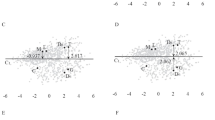Abstract
When some of observed variates do not conform to the model under consideration, they will have a serious effect on the results of statistical analysis. In factor analysis the model with inconsistent variates may result in improper solutions. In this article a useful method for identifying a variate as inconsistent is proposed in factor analysis. The procedure is based on the likelihood principle. Several statistical properties such as the effect of misspecified hypotheses, the problem of multiple comparisons, and robustness to violation of distributional assumptions are investigated. The procedure is illustrated by some examples.
Similar content being viewed by others
References
Akaike, H. (1974). A new look at the statistical model identification.IEEE Transactions on Automatic Control, AC-19, 716–723.
Akaike, H. (1987). Factor analysis and AIC.Psychometrika, 52, 317–332.
Amemiya, Y., & Anderson, T. W. (1990). Asymptotic chi-square tests for a large class of factor analysis models (Tech. Rep. No. 13, Stanford Univ., 1985).The Annals of Statistics, 18, 1453–1463.
Anderson, T. W. (1989). Linear latent variable models and covariance structures.Journal of Econometrics, 41, 91–119.
Bentler, P. M. (1983). Some contributions to efficient statistics in structural models: Specification and estimation of moment structures.Psychometrika, 48, 493–517.
Bentler, P. M. (1989).EQS structural equations program manual. Los Angeles: BMDP Statistical Software.
Boomsma, A. (1985). Nonconvergence, improper solutions, and starting values in LISREL maximum likelihood estimation.Psychometrika, 50, 229–242.
Browne, M. W. (1974). Generalized least squares estimators in the analysis of covariance structures.South African Statistical Journal, 8, 1–24.
Browne, M. W. (1982). Covariance structures. In D. M. Hawkins (Ed.),Topics in applied multivariate analysis (pp. 72–141). Cambridge: Cambridge University Press.
Browne, M. W. (1984). Asymptotically distribution-free methods for the analysis of covariance structures.British Journal of Mathematical and Statistical Psychology, 37, 62–83.
Browne, M., & Shapiro, A. (1988). Robustness of normal theory methods in the analysis of linear latent variate models.British Journal of Mathematical and Statistical Psychology, 41, 193–208.
Davis, F. B. (1944). Fundamental factors of comprehension in reading.Psychometrika, 9, 185–197.
Fujikoshi, Y. (1985). Selection of variables in two-group discriminant analysis by error rate and Akaike's information criteria.Journal of Multivariate Analysis, 17, 27–37.
Hochberg, Y., & Tamhane, A. C. (1987).Multiple comparison procedures. New York: Wiley.
Ihara, M., & Kano, Y. (1991, July).Variable selection in factor analysis. Paper presented at the 7th European Meeting of the Psychometric Society. Trier, Germany.
Ihara, M., & Okamoto, M. (1985). Experimental comparison of least-squares and maximum likelihood methods in factor analysis.Statistics & Probability Letters, 6, 287–293.
Jolliffe, I. T. (1986).Principal component analysis. New York: Springer-Verlag.
Jöreskog, K. G. (1967). Some contributions to maximum likelihood factor analysis.Psychometrika, 32, 443–482.
Jöreskog, K. G., & Sörbom, M. (1988).LISREL 7: A guide to the program and applications. Chicago: SPSS.
Kano, Y. (1990). Noniterative estimation and the choice of the number of factors in exploratory factor analysis.Psychometrika, 55, 277–291.
Kano, Y. (1993). Asymptotic properties of statistical inference based on Fisher consistent estimators in the analysis of covariance structures. In K. Haagen, D. J. Bartholomew, & M. Deistler (Eds.),Proceedings of the international workshop on statistical modelling and latent variables. Amsterdam: Elsevier Science Publisher.
Lawley, D. N., & Maxwell, A. E. (1971).Factor analysis as a statistical method (2nd ed.). London: Butterworths.
Lee, S. Y. (1980). Estimation of covariance structure models with parameters subject to functional restraints.Psychometrika, 45, 309–324.
Lee, S. Y., & Bentler, P. M. (1980). Some asymptotic properties of constrained generalized least squares estimation in covariance structure models.South African Statistical Journal, 14, 121–136.
Lee, S. Y., & Jennrich, R. I. (1979). A study of algorithms for covariance structure analysis with specific comparisons using factor analysis.Psychometrika, 44, 99–113.
Magnus, J. R., & Neudecker, H. (1988).Matrix differential calculus with applications in statistics and econometrics. New York: Wiley.
Mardia, K. V. (1970). Measures of multivariate skewness and kurtosis with applications.Biometrika, 57, 519–530.
Mardia, K. V. (1974). Applications of some measures of multivariate skewness and kurtosis in testing normality and robustness studies.Sankhyā, Series B, 36, 115–128.
Martin, J. K., & McDonald, R. P. (1975). Bayesian estimation in unrestricted factor analysis: A treatment for Heywood cases.Psychometrika, 40, 505–517.
Maxwell, A. E. (1961). Recent trends in factor analysis.Journal of the Royal Statistical Society, Series A, 124, 49–59.
Mooijaart, A., & Bentler, P. M. (1991). Robustness of normal theory statistics in structural equation models.Statistica Neerlandica, 45, 159–171.
Muirhead, R. J., & Waternaux, C. M. (1980). Asymptotic distributions in canonical analysis and other multivariate procedures for nonnormal populations.Biometrika, 67, 31–43.
Okamoto, M., & Ihara, M. (1984). Partial Gauss-Newton algorithm for least-squares and maximum likelihood methods in factor analysis.Journal of the Japan Statistical Society, 14, 137–144.
Rao, C. R. (1955). Estimation and tests of significance in factor analysis.Psychometrika, 20, 93–111.
Rao, C. R. (1973).Linear statistical inference and its application (2nd ed.). New York: Wiley.
Rindskopf, D. M. (1983). Parameterizing inequality constraints on unique variances in linear structural equation models.Psychometrika, 48, 73–83.
Ryan, T. A. (1959). Multiple comparisons in psychological research.Psychological Bulletin, 56, 26–47.
Ryan, T. A. (1960). Significance tests for multiple comparison of proportions, variances, and other statistics.Psychological Bulletin, 57, 318–328.
SAS Institute. (1988).SAS/STAT: User's guide (Vol. 1, Ver. 6, 4th ed.). Cary, NC: Author.
Sato, M. (1987). Pragmatic treatment of improper solutions in factor analysis.Annals of the Institute of Statistical Mathematics, Part B, 39, 443–455.
Satorra, A. (1989). Alternative test criteria in covariance structure analysis.Psychometrika, 54, 131–151.
Shapiro, A., & Browne, M. (1987). Analysis of covariance structures under elliptical distributions.Journal of the American Statistical Association, 82, 1092–1097.
Tanaka, Y. (1983). Some criteria for variable selection in factor analysis.Behaviormetrika, 13, 31–45.
van Driel, O. P. (1978). On various causes of improper solutions in maximum likelihood factor analysis.Psychometrika, 43, 225–243.
Yanai, H. (1980). A proposition of generalized method for forward selection of variables.Behaviormetrika, 7, 95–107.
Author information
Authors and Affiliations
Rights and permissions
About this article
Cite this article
Kano, Y., Ihara, M. Identification of inconsistent variates in factor analysis. Psychometrika 59, 5–20 (1994). https://doi.org/10.1007/BF02294262
Received:
Revised:
Issue Date:
DOI: https://doi.org/10.1007/BF02294262




